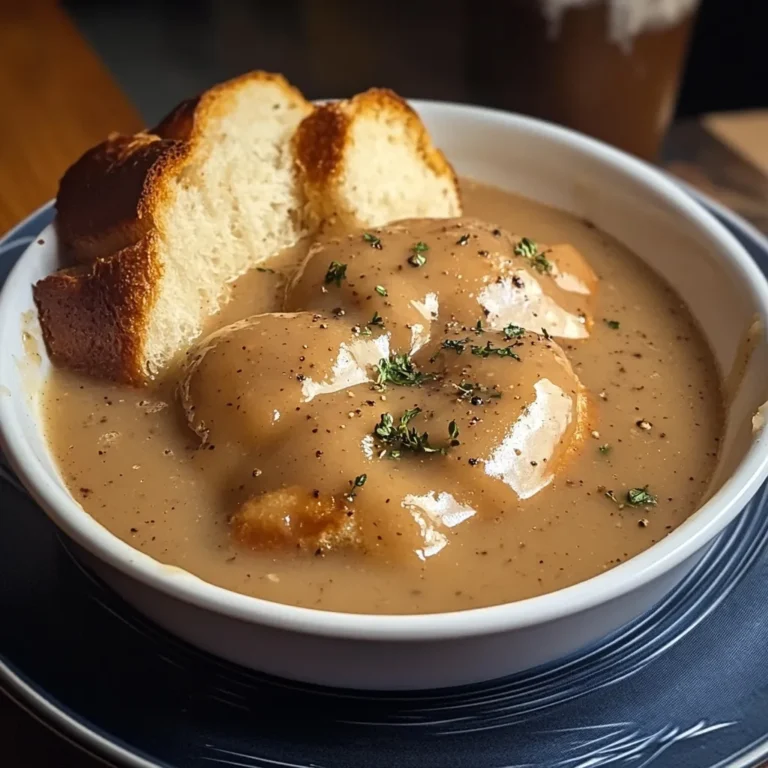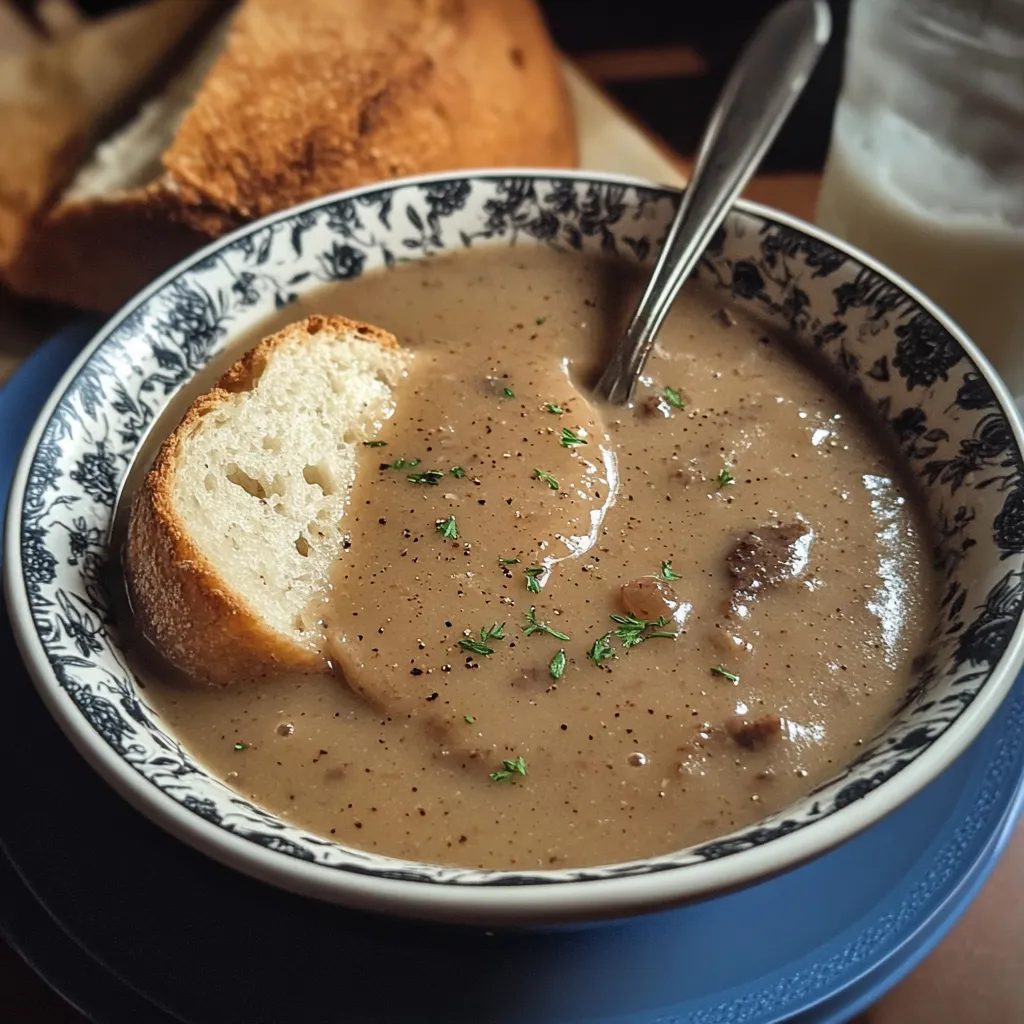Introduction
Gravy is an essential component of many meals, adding richness and flavor to everything from roasted turkey to mashed potatoes. Whether it’s a holiday feast or a weeknight dinner, learning how to make gravy from scratch can elevate your dishes to the next level. In this recipe, we will guide you through the process of creating a smooth, delicious gravy using turkey drippings or butter, paired with beef or chicken broth for a flavorful finish.
Overview of the Recipe
This classic gravy recipe uses turkey drippings or butter as the base, combined with beef or chicken broth to achieve a smooth and savory sauce. The key to a great gravy is developing a proper roux—a mixture of fat (in this case, drippings or butter) and flour—which serves as the thickening agent. With just a few ingredients and simple steps, you can create a homemade gravy that’s perfect for serving over meats, vegetables, or potatoes.
History and Origin of Gravy
Gravy has been a staple of traditional cuisines around the world for centuries. In its simplest form, gravy is made by deglazing the pan drippings left from roasting meats and then thickening them with flour or another starch. Its origins are rooted in European culinary traditions, particularly in French and British cooking. Over time, variations of gravy have emerged across different regions, with some using milk (as in Southern-style gravies) and others incorporating flavorful broths, like the one in this recipe.
Gravy became especially popular in the United States with the rise of Thanksgiving feasts, where it is commonly served alongside roasted turkey, mashed potatoes, and stuffing. Today, it is a beloved accompaniment in many households, enjoyed not only during holidays but also for everyday meals.
Ingredients
- 4 cups beef or chicken broth
- 1/4 cup all-purpose flour
- 1/4 cup turkey drippings or butter
- Salt and pepper to taste
Instructions
Prepare the Drippings or Butter:
If you’re using turkey drippings, collect them from the roasting pan after cooking your turkey. If you don’t have drippings, you can use butter as a substitute. Either way, you’ll need about 1/4 cup of fat for the base of the gravy.
Heat the Drippings or Butter:
In a medium saucepan, add the turkey drippings or butter. Heat over medium heat until it melts and becomes warm. If using drippings, make sure they are strained to remove any solid pieces before adding to the pan.
Create a Roux:
Gradually whisk in the flour to form a roux. Stir constantly to combine the fat and flour, allowing the mixture to cook for about 2-3 minutes. The goal is to cook the flour until it becomes golden brown and develops a nutty aroma. This step is essential for avoiding a raw flour taste in your gravy.
Add the Broth:
Slowly add the beef or chicken broth to the roux, whisking continuously. This step helps prevent lumps from forming. Once the broth is fully incorporated, increase the heat to bring the mixture to a boil.
Simmer the Gravy:
After the gravy has reached a boil, reduce the heat to low and let it simmer. Stir frequently as the gravy thickens, which should take about 10-15 minutes. If you prefer a thinner gravy, add a little more broth or water to achieve the desired consistency.
Season to Taste:
Once the gravy has thickened, season it with salt and pepper to taste. You can also add herbs like thyme or rosemary for additional flavor, though this is optional.
Serve:
Remove the gravy from the heat and serve it warm. Gravy is best when drizzled over turkey, chicken, beef, mashed potatoes, or stuffing.
Serving Suggestions
This gravy is a perfect match for roasted turkey, chicken, or beef dishes. It also pairs wonderfully with mashed potatoes, stuffing, or even over biscuits for a hearty breakfast. Serve it warm and make sure to pour generously over your meal for that extra burst of flavor.
Pairing and Serving Suggestions
Gravy enhances the flavor of savory dishes and goes well with various side dishes and mains. Here are a few suggestions on how to pair and serve your homemade gravy:
- Roasted Meats: Use this gravy to complement roasted turkey, chicken, or beef. Its rich and smooth texture will elevate the flavor of the meat.
- Mashed Potatoes: A classic combination—gravy adds a delicious, velvety layer to fluffy mashed potatoes.
- Stuffing: Serve alongside your favorite stuffing recipe for an added depth of flavor.
- Vegetables: Drizzle over roasted or steamed vegetables like carrots, green beans, or broccoli for an extra savory touch.
- Biscuits: For a Southern-style meal, serve this gravy over freshly baked biscuits.
Variations of the Recipe
- Herb-Infused Gravy: Add a tablespoon of chopped fresh herbs like rosemary, thyme, or sage to the gravy for an herbaceous twist.
- Onion Gravy: Sauté onions in the drippings or butter before adding the flour. The caramelized onions will add a rich, sweet flavor to the gravy.
- Garlic Gravy: Add minced garlic to the roux for a more aromatic and flavorful gravy.
- Vegetarian Gravy: Replace the turkey drippings with butter or olive oil and use vegetable broth instead of beef or chicken broth for a vegetarian-friendly version.
Health Benefits of Gravy
While gravy is typically enjoyed as a comfort food, it can have some nutritional benefits depending on the ingredients used. By making your gravy at home, you can control the amount of fat and sodium, making it healthier than store-bought versions.
- Protein-Rich: When using turkey or beef drippings, the gravy can provide a small amount of protein.
- Low in Saturated Fats: Using butter instead of drippings can lower the amount of saturated fats.
- Nutrient-Rich Broth: Using homemade beef or chicken broth can add essential vitamins and minerals like collagen, calcium, and iron.
To make the gravy even healthier, consider using whole-wheat flour or a gluten-free alternative for those with dietary restrictions.
FAQs
- Can I make gravy without drippings?
Yes! If you don’t have drippings, you can use butter or a combination of butter and olive oil as the fat base for the gravy. - How can I fix lumpy gravy?
If your gravy turns out lumpy, you can strain it through a fine mesh sieve or use an immersion blender to smooth it out. - Can I make gravy ahead of time?
Absolutely. You can make gravy ahead of time and reheat it before serving. If it thickens too much, simply add a splash of broth or water while reheating. - How can I store leftover gravy?
Store leftover gravy in an airtight container in the refrigerator for up to 3-4 days. You can also freeze gravy for up to 3 months. - Can I use cornstarch instead of flour?
Yes, cornstarch can be used as a thickening agent instead of flour. Use half the amount of cornstarch and dissolve it in cold water before adding it to the broth to prevent clumping.
Conclusion
Gravy is a classic sauce that brings warmth and flavor to any meal. With this simple recipe, you can easily make your own homemade gravy using turkey drippings or butter, combined with beef or chicken broth for a savory and smooth finish. Whether you’re preparing a holiday feast or an everyday meal, this versatile gravy will take your dishes to the next level. By mastering the technique of making a roux and choosing quality ingredients, you’ll be able to create a delicious, rich gravy that your family will love. Experiment with variations to make it your own, and enjoy it paired with your favorite meats, vegetables, or sides.

Classic Gravy Recipe: How to Make Perfect Homemade Gravy Every Time
Description
A rich and savory homemade gravy made with turkey drippings or butter, beef or chicken broth, and thickened with flour. This versatile sauce is ideal for serving with roasted meats, mashed potatoes, and vegetables.
Ingredients
- 4 cups beef or chicken broth
- 1/4 cup all-purpose flour
- 1/4 cup turkey drippings or butter
- Salt and pepper to taste
Instructions
- Heat the turkey drippings or butter in a medium saucepan over medium heat.
- Whisk in the flour to create a roux, and cook until golden brown (about 2-3 minutes).
- Slowly add the broth while whisking constantly to avoid lumps. Bring the mixture to a boil.
- Reduce the heat to low and let the gravy simmer, stirring often, until it thickens (about 10-15 minutes).
- Season with salt and pepper to taste, then remove from heat and serve warm.
Notes
- If you don’t have turkey drippings, butter is a great substitute that will still give the gravy a rich texture.
- Adjust the consistency by adding more broth if the gravy is too thick.
- Fresh herbs like thyme or rosemary can be added for extra flavor.
- Use cornstarch instead of flour for a gluten-free version.


